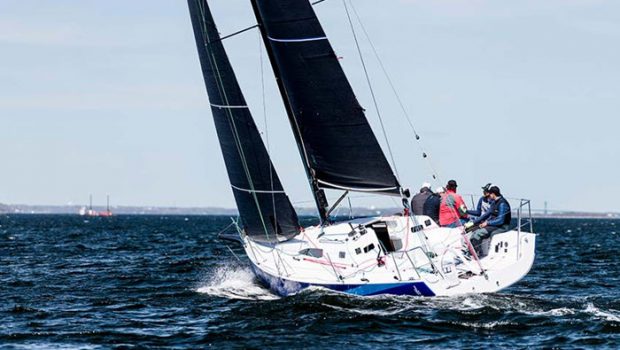Using the tools to depower the mainsail
Published on August 25th, 2022
The breeze is up, or a puff is on, and you need to depower the mainsail ASAP. So, which do you reach for, the sheet or the traveler? Quantum Sails experts, Dave Flynn and Todd Basch, weigh in with their thoughts.
“I am a mainsail trimmer and my skipper and I are always arguing about depowering. Which should I be using, the traveler or the mainsheet?”
Technically, no one is wrong here. Depending on the situation and the boat, you can use either, both, or even something else! Here’s the breakdown:
Traveler
We’ll call this the “small hammer.” The traveler has two functions: it controls the boom’s angle to the wind and it helps steer the boat, controlling helm and heeling in puffs and lulls.
Set the twist with the mainsheet then use the traveler to position the boom on the centerline for maximum power and pointing, as long as helm and heeling are under control. As the breeze builds and mainsheet tension increases, the traveler will gradually be dropped to keep the boom on the centerline.
In medium breeze, the role of the traveler will expand to include maintaining control of helm. As the boat heels too far and generates weather helm, you can drop the traveler to depower the boat. The position of the boom, relative to the centerline, will become irrelevant.
In this wind range, play the traveler aggressively to maintain the correct amount of helm. Dump the traveler down quickly at the onset of a puff, but then be ready to pull it right back up as the initial power of the puff dissipates and turns into forward speed instead of heel. If you leave it down too long you will miss the opportunity to point once you’ve accelerated.
In medium air, the range of adjustment on the traveler will be wide, from the boom on centerline to all the way down to leeward.
Think of the traveler as the “fine tune” power control device. As long as the changes in velocity are not too rapid and too great, it will keep the boat on its feet (and stop the helmsperson’s whining). The beauty of using the traveler is that mainsail twist (controlled by the mainsheet), which is vital to both speed and pointing, does not change, only the total amount of power.
In shifty or puffy conditions, or in a lively sea-state, the trimmer might have to ease or trim a lot — maybe even constantly. Using the traveler, instead of the sheet, reduces the amount of muscle the trimmer will need to use — it’s less of a lift that can have a lot of impact. Over time, the lower-effort option may just save your trimmers’ arms and back.
In very puffy conditions when velocity and direction are changing rapidly, the sheet can be a better tool to control power. This is a technique called “vang sheeting,” because the vang takes over the job of pulling down on the boom and controlling twist. The mainsheet moves the boom in and out to reach proper trim. Typically the traveler is pulled part of the way back up towards the centerline to keep the bottom of the mainsail working.
Once the velocity has increased to the point that the traveler alone will not keep the boat upright, it’s time to use the big stick and shift over to the mainsheet.
Mainsheet
The mainsheet is the “big hammer” when it comes to adjustment for the overall amount of power.
The type of boat and its performance characteristics also influence the choice. On fractional rigged boats with large mainsails (particularly when the boat is on the lighter side), the mainsheet is played somewhat more aggressively and the traveler is usually kept closer to centerline. The bigger sail makes the boatspeed particularly sensitive to small changes in mainsheet tension. The right amount of twist is key.
Of course, the sophisticated mainsail trimmer continually makes adjustments to both traveler and mainsheet based not just on the overall amount of power, but also on issues like boat speed, waves, and even tactical situations.
For example, the trimmer may ease the mainsheet slightly and drop the traveler to depower if the boat is sailing slower than targets or about to hit a set of waves. Or, if you are lifted or close to fetching the weather mark, it may pay to ease the mainsheet and lower the traveler more aggressively to turn a puff into speed instead of height.
If you’re going downwind and you’ve got the sheet pretty far out, you won’t have much more to give, so even if you’re committed to adjusting the mainsheet, there may be a time where the traveler or vang is a better tool.
All in all, there may not truly be a right answer here. To paraphrase rather badly from an ancient Zen saying, as in all things, the correct answer lies in the middle way. Or, to take inspiration from a younger generation — you do you.
A few more things to remember:
• Don’t forget the role the backstay has in controlling power — you may be able to give your main trimmer a hand by playing the backstay more efficiently. If you put on a lot of backstay, it will also tighten the forestay. This straightens not only the jib’s luff, but also flattens the main. Together, these will impact power and provide a little more stability.
• Make sure your main and jib trimmer are coordinating their efforts. Yes, you can depower the main, but as soon as it’s backwinded it will start to cause some trouble up front.
• Utilizing the traveler, main, vang, and backstay each have different impacts on different boats, depending on their weight, size, setup and maneuverability. Every boat has its nuances, so choose what strategy is right for you and your crew.









 We’ll keep your information safe.
We’ll keep your information safe.